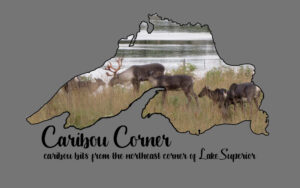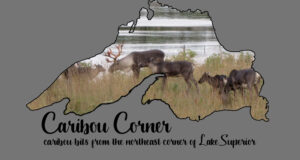 Caribou are members of the deer family (Cervidae – from the Latin word for stag) along with moose, elk, and white-tailed deer of course. There are also another 22 species native to North and South America, Europe and Asia. The deer family are hoofed mammals with a rumen to help digest their vegetarian diet. The rumen is the first of four stomach compartments. It pre-processes their food which they then regurgitate, chew again, and send back down – just like cattle chewing their cud.
Caribou are members of the deer family (Cervidae – from the Latin word for stag) along with moose, elk, and white-tailed deer of course. There are also another 22 species native to North and South America, Europe and Asia. The deer family are hoofed mammals with a rumen to help digest their vegetarian diet. The rumen is the first of four stomach compartments. It pre-processes their food which they then regurgitate, chew again, and send back down – just like cattle chewing their cud.
Deer are distinguished from other ruminants in that the males of all species have antlers that are replaced every year. Caribou are unique among the deer because female caribou regularly have antlers. In the other ruminants both sexes have horns (bison and mountain sheep for example) or furred ossicones (on giraffes) – these continue to grow year after year.
Caribou have a circumpolar distribution in the northern parts of North America, Europe, and Asia. In Europe and Asia caribou are called reindeer. There are some biologists who think that Santa actually has caribou pulling his sleigh because the North Pole is closer to the caribou of the Canadian High Arctic than to the Eurasian reindeer. In contrast, the few caribou left in the northeast part of Lake Superior are some of the southernmost caribou or reindeer in the world.
The name caribou comes from the Mi’kmaq word qalipu, meaning “pawer of snow” because of their cratering to get food in winter. Rein is from the old Norse word for the species, and deer comes from a middle English word meaning any wild animal. There are also dozens of other names for caribou and reindeer in the local languages around the world where these animals are found. In Ontario, caribou are called atik or adik in Cree and Ojibwe, as in Atikokan. Their scientific or Latin name is Rangifer tarandus. Rangifer comes from the northern European Saami word for reindeer and tarandus comes from the Greek word for reindeer.
Coming up next: The Diversity of Caribou (and Reindeer)
If you would like to know more about the Lake Superior caribou and how to save the last of the mainland caribou around Lake Superior, see www.lakesuperiorcaribou.ca
- LDHC Long Term Care Unit COVID-19 Outbreak - December 31, 2025
- Physician Staffing Pressure January 1st, 2026 - December 30, 2025
- Black River-Matheson Opens Warming Station - December 29, 2025
 Wawa-news.com You can't hear the 'big picture'!
Wawa-news.com You can't hear the 'big picture'!
